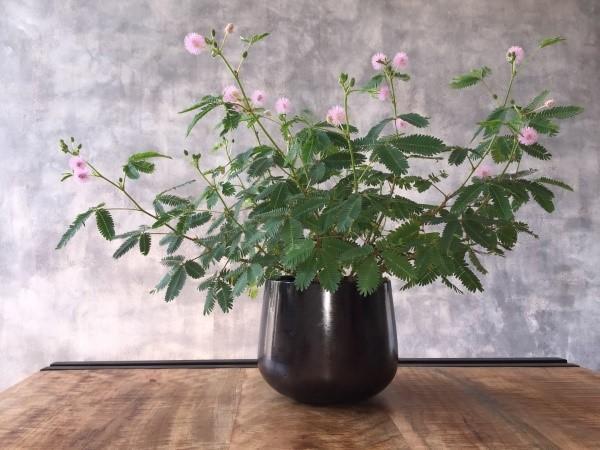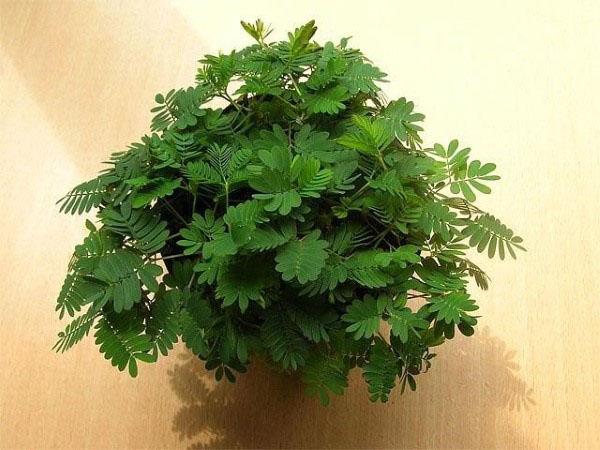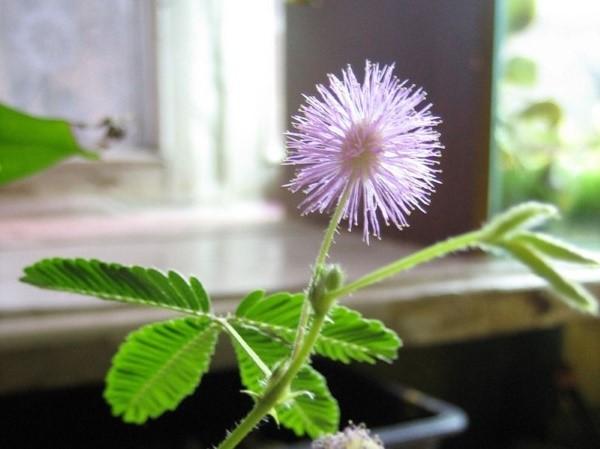Let the bashful mimosa decorate your home, growing a sissy flower
 Not all growers have bashful mimosa, the cultivation of which can only be done by the most scrupulous plant lovers. Take, for example, that by its nature it is a garden culture. But even in indoor conditions, mimosa requires a special attitude towards itself. She is a real touchy, with special requirements for conditions of detention. Not every room will grow and will react differently to your touch, in the truest sense of the word, not like other indoor plants. Why is it so special and how can you still grow this flower at home?
Not all growers have bashful mimosa, the cultivation of which can only be done by the most scrupulous plant lovers. Take, for example, that by its nature it is a garden culture. But even in indoor conditions, mimosa requires a special attitude towards itself. She is a real touchy, with special requirements for conditions of detention. Not every room will grow and will react differently to your touch, in the truest sense of the word, not like other indoor plants. Why is it so special and how can you still grow this flower at home?
Description of the plant

The maximum that a bashful mimosa flower can "catch up" is 40 cm.
It is not for nothing that mimosa is called a sissy: its shoots are thin, fragile and almost weightless. To complete the airy image, the whole plant, both stems and leaves, is covered with very small light thorns. From a distance, they look more like hairs. It seems that the bush is silvering under the sun's rays.
In nature and with proper care at home, mimosa blooms for almost 4 months, from summer to early autumn.
 Inflorescences are small, round and fluffy, painted in pale pink color. In the open field, the wind helps pollination, shaking the stems and forcing the flowers to touch. At home, you can help the flower by gently bending the twigs so that the inflorescences touch each other. Then it will be possible to get seeds - small shaggy pods with beans.
Inflorescences are small, round and fluffy, painted in pale pink color. In the open field, the wind helps pollination, shaking the stems and forcing the flowers to touch. At home, you can help the flower by gently bending the twigs so that the inflorescences touch each other. Then it will be possible to get seeds - small shaggy pods with beans.
What is the peculiarity of room mimosa bashful
 The main "highlight" of the bashful mimosa is not even the flowers, although the fluffy pink pompons also look gentle. Leaves give originality to the plant: many pinnate elongated plates on an even petiole. They have one interesting ability, which gave mimosa a "bashful character". At the slightest touch, they close, fold along the petiole, and descend. If the bush is not disturbed for half an hour, the leaves return to their original position. By the way, mimosa closes at night too.
The main "highlight" of the bashful mimosa is not even the flowers, although the fluffy pink pompons also look gentle. Leaves give originality to the plant: many pinnate elongated plates on an even petiole. They have one interesting ability, which gave mimosa a "bashful character". At the slightest touch, they close, fold along the petiole, and descend. If the bush is not disturbed for half an hour, the leaves return to their original position. By the way, mimosa closes at night too.
Mimosa is "ashamed" not only if you touch it. In the same way, she reacts to a slight breeze from the window, a draft, tobacco smoke and fumes during cooking. It is not difficult to understand that constant charging depletes the plant and causes its death.
Light, warmth and peace are the main things for mimosa
 Having decided to get yourself this whim, take a responsible approach to choosing a place for a flower. Mimosa needs good lighting. If she misses the sun, the already fragile shoots will become even thinner. The bush will begin to fall apart, the twigs will stretch out and may break.
Having decided to get yourself this whim, take a responsible approach to choosing a place for a flower. Mimosa needs good lighting. If she misses the sun, the already fragile shoots will become even thinner. The bush will begin to fall apart, the twigs will stretch out and may break.
Some gardeners for the summer tried to take a pot of mimosa into the garden.However, in most cases, she behaved differently from other indoor flowers. If the bush is comfortable in the house even on the southern window, then burns appear on the tender leaves on the street.
As a tropical crop, mimosa needs warmth. The optimum temperature for keeping a plant during the period of active growth is at least 22 ° C. At the same time, in winter, it is better to find a cooler room for her - no higher than 16 ° C. This is due to the increased requirements of the plant for air humidity. When the heating is working, it decreases several times, and mimosa cannot stand this, especially if the room is warm. Here is another reason that mimosa cannot be an indoor perennial - it simply dies during the winter.
Another important nuance: the window where your mimosa will stand should not open. Even the smallest wind will disturb the foliage, and from constant movement the bush will quickly deplete and die. Also, do not put a flowerpot in the kitchen, balcony and the terrace, especially if there are smokers. Hot air and steam from "kitchen activities" and cigarette smoke will kill the plant. First it will shed its leaves, and then it will completely disappear.
Mimosa bashful - growing a plant
 The surest way to grow a bashful flower is to sow seeds. To get started, you can buy them at the store and then collect your own by waiting for the pods to dry. Mimosa germination is good, but given that the shell of the beans is dense, fill them with warm water before sowing. Let them lie down for half an hour, and then you can plant. You do not need to bury much, just make a hole no more than 1 cm deep, put a seed and level the soil. Plant immediately in separate pots so as not to dive the seedlings and accidentally damage the roots.
The surest way to grow a bashful flower is to sow seeds. To get started, you can buy them at the store and then collect your own by waiting for the pods to dry. Mimosa germination is good, but given that the shell of the beans is dense, fill them with warm water before sowing. Let them lie down for half an hour, and then you can plant. You do not need to bury much, just make a hole no more than 1 cm deep, put a seed and level the soil. Plant immediately in separate pots so as not to dive the seedlings and accidentally damage the roots.
Put the collected seeds from a home plant in a bag (paper) and store in the refrigerator until spring.
 Choose a loose and nutritious soil for growing mimosa. For sprouting beans in the first stage, you can use peat.
Choose a loose and nutritious soil for growing mimosa. For sprouting beans in the first stage, you can use peat.
In the future, for transplanting mimosa seedlings, mix:
- 2 shares of leafy land;
- 1 beat each peat and sand.
Like any seedling, seeds should germinate in a greenhouse, under a film. You can transplant the bushes to a permanent place in the pot when they grow up to 5 cm in height. In doing so, use the transshipment method, lightly shaking off the peat from the roots.
Caring for bashful mimosa at home
 If you properly organize the conditions of detention, pick up light soil, all that remains is to support the development of the plant.
If you properly organize the conditions of detention, pick up light soil, all that remains is to support the development of the plant.
Further care of the flower will consist of the following activities:
- Watering. Try to find a middle ground: do not fill, but also do not allow the substrate to dry out completely. In the spring and summer, water the flower every 3 days with settled water. From autumn, when mimosa "moves" to a cool room, it is enough to moisten the soil once a week.
- To increase the humidity in the air, place the flowerpot on a tray with pebbles and a little water. You can also spray periodically, but not the mimosa itself, but the air around it. If water gets on the leaves, they will react and close.
- Top dressing. Since March, when the bashful mimosa from seeds is actively developing, start applying once every 2 weeks mineral complex for flowering plants... At the same time, keep in mind that she likes to "eat" well, but modestly. Therefore, reduce the concentration of the working solution by 2 times.
If you manage to keep the bashful mimosa in winter, cut the branches that are stretched out in the spring. There are good chances that the bush will recover and live another season.
You can also try to propagate your mimosa using cuttings. However, be prepared for a 1:10 chance of a positive result. Cuttings are extremely reluctant to root, so seeds are the most reliable way to grow bashful mimosa. Even if they need to be sown annually, it is worth doing, because not everyone has such a flower.